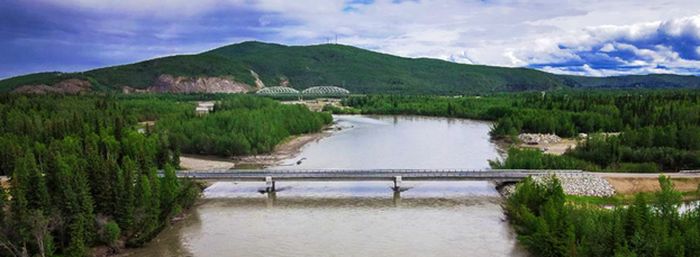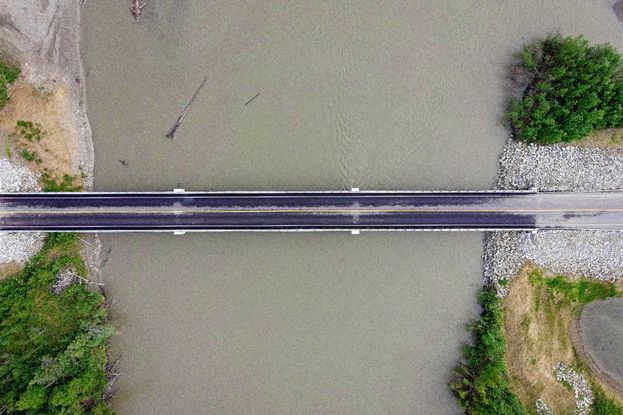Nenana Totchaket Road Project Number: NSHWY00657

An aerial view of the Nenana-Totchaket Bridge. DOT&PF photo.
The Alaska Department of Transportation and Public Facilities (DOT&PF), in collaboration with the community of Nenana, has awarded a contract for construction to Brice, Ltd., using a Construction Manager/General Contractor (CMGC) delivery method to make necessary repairs to the existing twelve-mile Totchaket Road.
The project also proposes to extend the road by 4.7 miles to the end of the Phase 1 agricultural development area designated by Alaska DNR.
After receiving feedback during community listening sessions, DOT&PF elected to pursue a staged approach to construction to ensure ample opportunities for input.
Stage 1 focuses on resurfacing and repairing the existing 12 mile Totchaket Road. Construction began in Winter 2022/23, and will be completed Spring 2023.
Stage 2 is anticipated to be completed in several substages. Stage 2a will replace culverts around Five Mile Slough and improve drainage in the area. Stage 2b proposes to construct 4.7 miles of new road to improve access to the DNR Phase 1 agricultural development plots and food security possibilities identified by planning efforts with the community and state agencies. Stage 2c will replace the three smaller bridges to the west of the Nenana River bridge on the Totchaket Road. Design for these bridges is underway.
Stage 3 will construct subdivision roads north of the existing and extended Totchaket road to allow access to agricultural project lots. This project is possible through reappropriated funds from the legislature and Governor Dunleavy.
Beginning in 2009, construction of the existing 12-mile Totchaket Road and associated bridges was a collaborative effort between multiple local stakeholders, including the City of Nenana, the Nenana Native Association (Tribe), the Toghotthele Corporation, and Doyon. The Nenana River Bridge was completed in 2020 through a close partnership between the tribe and city, thereby opening up the Totchaket area to public access year-round.
Stage One: Existing Road Repairs
The existing 12-mile Totchaket Road has been re-leveled in areas that have experienced settling, flattening of embankment side slopes, resurfacing, and clearing of vegetation. Existing turnouts were improved, as well as the construction of new turnouts needed to support construction.
Stage Two: Three sub-stages for road development and improvement
2a: Replace and upgrade culverts and drainage through the Five Mile Slough area. Culverts will be upgraded to two eight-foot diameter culverts under the road to improve flow and carry extra seasonal capacity to a 50-year flood event standard. A four-foot diameter relief culvert will also be added.
2b: The Nenana-Totchaket area has a long planning history as an agricultural development, but limited access to the region delayed development. Since then, renewable resources like agriculture have become more viable as growing seasons are changing in an evolving Arctic environment. A 4.7 mile road extension to the end of the DNR Phase 1 Agricultural Project is proposed to support food security from Alaska's soils by accessible access to a region abundant in resources. The Alaska Department of Natural Resources values access to agriculture land and is a collaborator on this project.
Permit applications to the US Army Corps of Engineers for further construction beyond the 4.7 mile extension to the edge of the Agricultural Project have been dropped. A cultural resources permit has also been downscaled to match this shorter extension and does not include any further road length development at this time.
2c: DOT&PF proposes to replace or rehabilitate three bridge crossings (East Middle, West Middle, and Little Nenana Rivers).
In 2018, the Nenana Native Association, in partnership with the city, was awarded a $9 million federal grant to fund the 450 foot Nenana-Totchaket Bridge intended to help members of the community thrive. Construction of the new bridge, managed by the native association, was vital to development of state-owned land, Alaska Native Corporations, and the University of Alaska.

The existing road to Totchaket consists of 5 bridges.
Timeline of Construction
The CMGC procurement method supports early engagement with the contractor, Brice. Together, DOT&PF and Brice continue to dialogue with the community of Nenana, agencies, and stakeholders to stage work in a collaborative way. This is evidenced by changes made to the initial scope of work which now separates out existing road repair from new construction to allow for continued community input.
Below is a high-level summary of the construction sequencing plan.
Stage 1: includes improvements to the existing Totchaket road (Complete as of March 2023)
- Brush clearing to improve site distance, safety, and reduce snow drifts.
- Resurfacing the existing road and turnouts
- Fixing areas of the existing road experiencing rutting
Stage 2: Work is anticipated to include new road construction 4.7 miles to the end of the DNR Agricultural Project, Five Mile Slough drainage improvements, and replacement of three small bridges.
- Construct new drainage structures at 5 mile slough. (Work completed Spring 2023)
- 4.7 mile road extension to the end of the Agricultural Project. (Work Completed Fall of 2023)
- Bridge work associated with the Little Nenana, East Middle and West Middle River crossings. (Work Completed Summer 2024)
- Widening the road to 24 feet west of the Little Nenana River. (Summer 2024)
Stage 3: Development of subdivision roads with DNR for access to agricultural project land plots. (Construction over winter 2024 into the Summer of 2025)
Project Information
- Listening Session Common Topics (FAQs)
- Listening Session Notes 12/12/22
- Road Site Visit Summary 2022 14MB
- Figure 1-4 5MB
- Figure 5
- P&P F12-F39 5MB
- Mass Haul Report
- Public Notice -POA 2022-00265 Multiple Waterways 16MB
- State Checklist - Existing Road Improvements
- State Checklist Appendix A - Project Figures 24MB
- State Checklist Appendix B - Historic Properties and Cultural Impacts 35MB
- State Checklist Appendix C - Vegetation Map 76MB
- State Checklist Appendix C - Wetland Delineation Report 9MB
- State Checklist Appendix C - Wetland Delineation Datasheets 32MB
- State Checklist Appendix C - Wetland Map 16MB
- State Checklist Appendix D - Eagle&Raptor Nest Survey 4MB
- State Checklist Appendix E - Water Quality
- State Checklist Appendix F - Public Involvement 14MB
- State Checklist Appendix G - Agency Involvement 44MB
- Bridge Info 27MB
- Cross Sections 16MB
- Geotech Investigation 12MB
- Subsurface Investigation 1981 9MB
- Soil Survey 1980 8MB
- DNR Agricultural Project Information
- DNR Nenana-Totchaket Agricultural Project History
- Review of State Laws Affecting Agriculture
- Alaska Department of Fish & Game
- ADF&G Board of Game Process

Use DOT&PF’s Alaska Project Exchange tools to learn more about all of DOT&PF’s active construction projects statewide!
Want to know how construction will impact road traffic? Visit 511.alaska.gov
Want to dig into the details about projects across the state? Visit dot.alaska.gov/construction
If you have any questions or comments about the project, please contact:
Joseph Kemp. P.E.
Northern Region Director
Alaska DOT&PF
2301 Peger Rd
Fairbanks, AK 99709-5316
(907) 451-2211
joseph.kemp@alaska.gov
For individuals requiring TTY communications, please contact Alaska Relay at 7-1-1 or 1-800-770-8973.
PLEASE NOTE: Adobe Acrobat PDF files require a free viewer available directly from Adobe.

